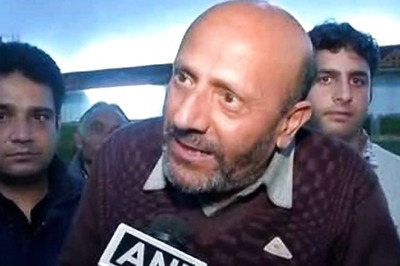
views
Every thing that Sania Mirza does on and off court appears to make news. From her dangling ear-rings, her dazzling nose-ring, her delightfully bold t-shirts, to, of course, her tennis exploits.
At a time when our cricketers are choking to disaster, Mirza seems to be just what the Indian sports fan desperately needs: a sporting icon, with lots of glamour and even more attitude.
And yet, being Sania Mirza cannot be easy. Bad enough that you are supposed to meet the expectations of a country with limited sporting achievement, there are also those who will choose to search for controversy.
Which is why a ?fatwa? from an obscure Islamic organization insisting that the teenage poster girl stop wearing short skirts made it to the front page of several national dailies. When Sania was asked for a response to the issue at a recent press conference, she simply shrugged it off. Maybe, next time she needs to blast a trademark forehand at the mischief-mongers (remember, Sania's fashion statement, "well-behaved women do not make history").
While the controversy will hopefully die down, it does highlight the triple burden which confronts the 18 year old potential superstar: she plays a sport other than cricket, she is a woman and she is a Muslim.
To be a champion sportswoman in India is even more difficult than being a top-grade male athlete. This, despite the fact that some of our women have actually outperformed their male counterparts (the Indian women's hockey team and our women weighlifters are classic examples).
Yet, in the last 58 years, there has been only one individual woman athlete who really has managed to make a mark at the highest international level, and that was PT Usha in the 1984 Los Angeles Olympics. The fact is, that till recently, sports was trapped in a familiar patriarchal set-up, where women were expected to stay in the kitchen, while the men could engage in the rough and tumble of sporting activity. The only state which was able to successfully break out of this male-dominated system was Kerala where the rise of the woman athlete is directly co-related to extremely high levels of female literacy and a resultant greater sense of gender equality.
Is it any surprise that a majority of the sportswomen, from Usha to Anju Bobby George, who have won national recognition are from Kerala? Its only now, with the emergence of a new metropolitan culture in which nuclear families are realizing the importance of sports as a vehicle for social mobility, that women athletes from cities like Bangalore and Hyderabad have actually begun to make a mark.
Just how tediously slow this process has been is exemplified by the fact that Sania is actually only the first Indian woman to make it to even the second round of the US Open.
But while breaking the gender barrier is important, it's the religious dimension that is intriguing and far more complex. The obvious response of right-thinking, reasonable Indians would be that Sania should be seen for what she is: a highly talented 18 year old representing the country on the world stage and reveling in the attention.
Why see Sania in any narrow, bigoted sense, even if only as a symbol of minority achievement? It's a valid question, but the validity of which cannot mask a certain reality: Sania Mirza is, of course, a potential national treasure, but she is also, importantly, a terminator of a certain stereotype.
The Indian middle-class will not admit it readily, but the fact is that in recent years the identity of the Indian Muslim has been sought to be boxed into certain categories: the Muslim as unthinking bigot, as anti-reform, as even worse, anti-national criminal.
The dominant image has been of a community caught in a time-warp, whose elders are backward-looking, whose youngsters see Osama as their hero, and whose women are forced to live in the shadow of the veil. This stereotyping has been accentuated in the post-9/11 universe, partly as a result of a media over-simplification, in part because of a failure of the community?s so-called leaders to recognize the need to embrace modernity and also because of the rise of a hate machine that revels in every little instance of minority bashing.
The recent Imrana case provided a classic example of how easy it is to fall into the trap of communal prejudice. One case in an obscure western Uttar Pradesh village is played out as a national 'media event' with all the familiar elements: a raped, helpless Muslim woman, a group of bearded maulvis who appear to show little concern for her, a 'fatwa' whose origins are shrouded in mystery, and a local community which chooses not to intervene. The combination is designed to only have one effect: reinforce the image of the Muslim as an evil, anti-woman obscurantist.
Unfortunately, while rightly highlighting and challenging the extra-judicial powers of the Shariat courts, few have chosen to examine the extra-constitutional powers arrogated by caste panchayats across the region, where a Dalit woman could be paraded naked in the streets just as easily as a Muslim woman could be denied her basic freedoms.
Which is why being Sania Mirza in today's age is important. She represents the empowered modern Indian woman's desire to be freed of the shackles of the past, expressing a joyous individuality that lies at the heart of a robust democratic society. For groups like the All India Muslim Personal law board, which have struggled to come to terms with modernity, a Sania Mirza is the perfect reason why such organizations must reform or perish.
In a way, her fashion statements offer the best response to those who would still prefer their women to hide behind the purdah, oppressed by antiquated laws. Much in the manner that those who walk the ramp at Fashion Week hold out against the VHP-type cultural police who would like a ban on any expression of individual freedom.
It would, of course, be unfair to place the burden of an entire community on the young shoulders of a Sania at a time when her real test is on the court in a highly competitive sport. But sportspersons often are expected to play a role, either by choice or circumstance, that stretches beyond the boundary.
Many years ago, long before the match-fixing controversy broke, I interviewed the original Hyderabad sports hero, Mohammed Azharuddin, and asked him whether he had ever felt conscious of his Muslim identity when playing for the country. Azhar said that when he first played Pakistan, he had felt a need to over-perform, else he would have to face a barrage of criticism. Hopefully, India has moved on from the Azhar era, and the new generation of Indian cricketers ? the Zaheers, the Kaifs and the Pathans ? are freed of having to consistently prove their "Indianness".
Maybe also, as the success of the film Iqbal has shown, there is a growing desire to vault over the narrow confines of old identities, and create new ones.
Sania's ultimate identity will revolve around her sporting talent, but at the same time her spirit and ambition will be a reminder to her co-religionists of the challenges and opportunities that are being provided by modernity.



















Comments
0 comment